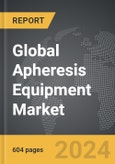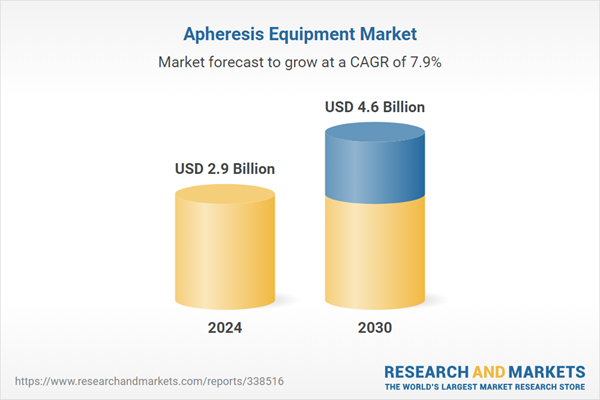The global market for Apheresis Equipment was valued at US$2.9 Billion in 2024 and is projected to reach US$4.6 Billion by 2030, growing at a CAGR of 7.9% from 2024 to 2030. This comprehensive report provides an in-depth analysis of market trends, drivers, and forecasts, helping you make informed business decisions. The report includes the most recent global tariff developments and how they impact the Apheresis Equipment market.
Segments: Type (Disposable Apheresis Kits, Plasma & Component Separator, Other Types); Technology (Centrifugation, Membrane Filtration); Procedure (Plasmapheresis, Plateletpheresis, Leukapheresis, Erythrocytapheresis, Other Procedures); Application (Neurology, Hematology, Renal Diseases, Other Applications).
Geographic Regions/Countries: World; USA; Canada; Japan; China; Europe; France; Germany; Italy; UK; Spain; Russia; Rest of Europe; Asia-Pacific; Australia; India; South Korea; Rest of Asia-Pacific; Latin America; Argentina; Brazil; Mexico; Rest of Latin America; Middle East; Iran; Israel; Saudi Arabia; UAE; Rest of Middle East; Africa.
The analysts continuously track trade developments worldwide, drawing insights from leading global economists and over 200 industry and policy institutions, including think tanks, trade organizations, and national economic advisory bodies. This intelligence is integrated into forecasting models to provide timely, data-driven analysis of emerging risks and opportunities.
Global Apheresis Equipment Market - Key Trends & Drivers Summarized
What Exactly Is Apheresis Equipment and How Does It Transform Lives?
Apheresis equipment refers to devices used in a medical procedure that separates the components of blood and collects one or more of these components while returning the rest to the donor or patient. This technology is vital in treating a variety of medical conditions and is used extensively in blood donation centers and hospitals. Apheresis is employed in the collection of platelets, plasma, red blood cells, and stem cells, which are critical in managing and treating conditions such as leukemia, lymphoma, various autoimmune disorders, and during chemotherapy treatments. The equipment includes a disposable kit, which ensures safety and hygiene by preventing cross-contamination, and a machine that centrifuges the blood to separate its components based on their density. This precise separation allows for targeted treatments, enhancing the effectiveness and reducing potential side effects of transfusions.How Are Technological Advancements Elevating Apheresis Procedures?
Recent technological advancements have significantly enhanced the efficiency and safety of apheresis equipment. Modern machines are equipped with automated systems that can adjust the flow rate and the amount of anticoagulant mixed with the blood, based on real-time feedback of the blood's characteristics. This automation minimizes the need for manual adjustments, reducing the risk of human error and increasing the comfort and safety of patients. Furthermore, the integration of advanced sensors and software analytics has improved the precision in component separation, ensuring that the extracted blood products are of high quality and the volume extracted is optimized, which is critical for patient safety and treatment efficacy. These advancements not only contribute to better health outcomes but also streamline the operation, making apheresis more accessible and faster, thereby benefiting more patients.What Role Does Apheresis Equipment Play in Modern Medicine?
Apheresis equipment plays a crucial role in modern medicine, particularly in the treatment and management of diseases where patients require frequent transfusions or immune system modulation. For example, in therapeutic plasma exchange, the equipment is used to remove and replace plasma that contains harmful antibodies with good plasma or a plasma substitute, which can be a lifeline for patients with autoimmune diseases. Similarly, in stem cell harvesting, apheresis equipment is used to collect stem cells from a donor's blood, which are then used in transplants to treat patients with cancers such as leukemia or lymphoma. This method is less invasive and more favorable compared to traditional bone marrow transplants. The ability of apheresis equipment to efficiently and safely collect these vital components makes it indispensable in many advanced therapeutic procedures and supports the ongoing research and clinical trials in regenerative medicine and immunotherapy.What Drives the Growth in the Apheresis Equipment Market?
The growth in the apheresis equipment market is driven by several factors that underscore the convergence of technology, healthcare needs, and demographic shifts. Increasing prevalence of chronic diseases globally, which often require blood component therapies, directly contributes to the demand for more sophisticated apheresis equipment. The technological advancements that enhance machine efficiency and patient safety also play a significant role, as they meet the stringent standards of modern healthcare practices. Furthermore, there is a growing awareness and acceptance of apheresis as a preferred method for collecting high-quality blood components necessary for treating complex conditions. This acceptance is further buoyed by the healthcare shift towards personalized medicine, where treatments are tailored to the specific needs of patients, often requiring components collected via apheresis. Lastly, the expansion of healthcare infrastructure across emerging markets and the increasing investments in blood donation programs and specialty clinics are pivotal in driving the adoption of advanced apheresis equipment. These factors, coupled with the rising number of elderly populations at risk for chronic diseases, ensure sustained growth and innovation in the sector, meeting both current and future healthcare challenges.Report Scope
The report analyzes the Apheresis Equipment market, presented in terms of units. The analysis covers the key segments and geographic regions outlined below.Segments: Type (Disposable Apheresis Kits, Plasma & Component Separator, Other Types); Technology (Centrifugation, Membrane Filtration); Procedure (Plasmapheresis, Plateletpheresis, Leukapheresis, Erythrocytapheresis, Other Procedures); Application (Neurology, Hematology, Renal Diseases, Other Applications).
Geographic Regions/Countries: World; USA; Canada; Japan; China; Europe; France; Germany; Italy; UK; Spain; Russia; Rest of Europe; Asia-Pacific; Australia; India; South Korea; Rest of Asia-Pacific; Latin America; Argentina; Brazil; Mexico; Rest of Latin America; Middle East; Iran; Israel; Saudi Arabia; UAE; Rest of Middle East; Africa.
Key Insights:
- Market Growth: Understand the significant growth trajectory of the Disposable Apheresis Kits segment, which is expected to reach US$3.1 Billion by 2030 with a CAGR of a 8.2%. The Plasma & Component Separator segment is also set to grow at 7.3% CAGR over the analysis period.
- Regional Analysis: Gain insights into the U.S. market, valued at $997.4 Million in 2024, and China, forecasted to grow at an impressive 11.3% CAGR to reach $548.9 Million by 2030. Discover growth trends in other key regions, including Japan, Canada, Germany, and the Asia-Pacific.
Why You Should Buy This Report:
- Detailed Market Analysis: Access a thorough analysis of the Global Apheresis Equipment Market, covering all major geographic regions and market segments.
- Competitive Insights: Get an overview of the competitive landscape, including the market presence of major players across different geographies.
- Future Trends and Drivers: Understand the key trends and drivers shaping the future of the Global Apheresis Equipment Market.
- Actionable Insights: Benefit from actionable insights that can help you identify new revenue opportunities and make strategic business decisions.
Key Questions Answered:
- How is the Global Apheresis Equipment Market expected to evolve by 2030?
- What are the main drivers and restraints affecting the market?
- Which market segments will grow the most over the forecast period?
- How will market shares for different regions and segments change by 2030?
- Who are the leading players in the market, and what are their prospects?
Report Features:
- Comprehensive Market Data: Independent analysis of annual sales and market forecasts in US$ Million from 2024 to 2030.
- In-Depth Regional Analysis: Detailed insights into key markets, including the U.S., China, Japan, Canada, Europe, Asia-Pacific, Latin America, Middle East, and Africa.
- Company Profiles: Coverage of players such as B. Braun Melsungen AG, Kaneka Corporation, B. Braun Medical, Inc., Fresenius Kabi AG, Miltenyi Biotec GmbH and more.
- Complimentary Updates: Receive free report updates for one year to keep you informed of the latest market developments.
Some of the 24 companies featured in this Apheresis Equipment market report include:
- B. Braun Melsungen AG
- Kaneka Corporation
- B. Braun Medical, Inc.
- Fresenius Kabi AG
- Miltenyi Biotec GmbH
- Fresenius SE & Co. KGaA
- Kawasumi Laboratories, Inc.
- Nikkiso Co., Ltd.
- Fresenius Medical Care AG & Co. KgaA
- Asahi Kasei Medical Co., Ltd.
- Haemonetics Corporation
- HemaCare Corporation
- Mallinckrodt Pharmaceuticals
- Fresenius Kabi USA
- Aferetica Srl
Tariff Impact Analysis: Key Insights for 2025
Global tariff negotiations across 180+ countries are reshaping supply chains, costs, and competitiveness. This report reflects the latest developments as of April 2025 and incorporates forward-looking insights into the market outlook.The analysts continuously track trade developments worldwide, drawing insights from leading global economists and over 200 industry and policy institutions, including think tanks, trade organizations, and national economic advisory bodies. This intelligence is integrated into forecasting models to provide timely, data-driven analysis of emerging risks and opportunities.
What’s Included in This Edition:
- Tariff-adjusted market forecasts by region and segment
- Analysis of cost and supply chain implications by sourcing and trade exposure
- Strategic insights into geographic shifts
Buyers receive a free July 2025 update with:
- Finalized tariff impacts and new trade agreement effects
- Updated projections reflecting global sourcing and cost shifts
- Expanded country-specific coverage across the industry
Table of Contents
I. METHODOLOGYII. EXECUTIVE SUMMARY2. FOCUS ON SELECT PLAYERSIII. MARKET ANALYSISCANADAITALYSPAINRUSSIAREST OF EUROPESOUTH KOREAREST OF ASIA-PACIFICARGENTINABRAZILMEXICOREST OF LATIN AMERICAIRANISRAELSAUDI ARABIAUNITED ARAB EMIRATESREST OF MIDDLE EASTIV. COMPETITION
1. MARKET OVERVIEW
3. MARKET TRENDS & DRIVERS
TECHNOLOGY OVERVIEW
4. GLOBAL MARKET PERSPECTIVE
UNITED STATES
JAPAN
CHINA
EUROPE
FRANCE
GERMANY
UNITED KINGDOM
ASIA-PACIFIC
AUSTRALIA
INDIA
LATIN AMERICA
MIDDLE EAST
AFRICA
Companies Mentioned (Partial List)
A selection of companies mentioned in this report includes, but is not limited to:
- B. Braun Melsungen AG
- Kaneka Corporation
- B. Braun Medical, Inc.
- Fresenius Kabi AG
- Miltenyi Biotec GmbH
- Fresenius SE & Co. KGaA
- Kawasumi Laboratories, Inc.
- Nikkiso Co., Ltd.
- Fresenius Medical Care AG & Co. KgaA
- Asahi Kasei Medical Co., Ltd.
- Haemonetics Corporation
- HemaCare Corporation
- Mallinckrodt Pharmaceuticals
- Fresenius Kabi USA
- Aferetica Srl
Table Information
| Report Attribute | Details |
|---|---|
| No. of Pages | 604 |
| Published | April 2025 |
| Forecast Period | 2024 - 2030 |
| Estimated Market Value ( USD | $ 2.9 Billion |
| Forecasted Market Value ( USD | $ 4.6 Billion |
| Compound Annual Growth Rate | 7.9% |
| Regions Covered | Global |









